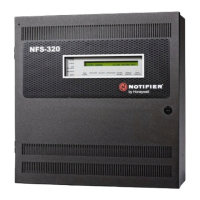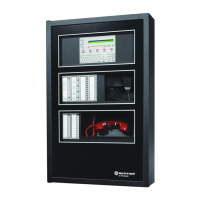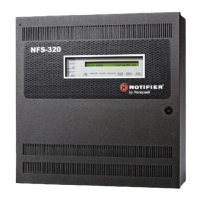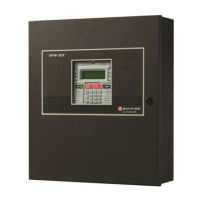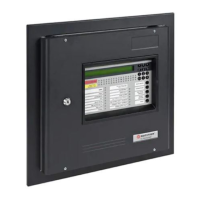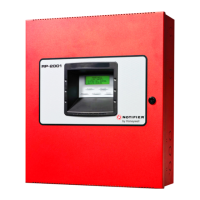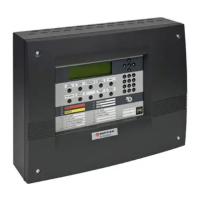38 NFS2-3030 Listing Document — P/N LS10006-051NF-E:F2 5/19/2022
POINT: Press this soft key to enter the ACS point number. The format is Axx-
Pyy, where A is the two-digit device address, P is the two-digit point number.
Enter a leading zero for one-digit numbers.
MODE: Press this soft key to enter the ACS mapping mode. Refer to Table 3
below.
SOURCE: Press to select the source field and also toggle between display for-
mats if a point value is allowed. Enter a point or zone, or the panel’s node num-
ber if the mode type is a system function such as acknowledge or reset.
Up to eight sources are allowed when
CONTROL mode is chosen.
• For ALL CALL, PAGE INACTIVE, PAGE EVAC, and PAGE ALERT, enter
the node number of the DVC where the source is connected.
• For
TELEPHONE mode, enter the address of the telephone module point
using the format NxxXLyyMzzz. Use the format NxxxAyyT (where
xxx=the node number and yy = the digital audio amplifier address) for FFTs on risers that have no FTM-1 modules installed.
FFT-NFN mode sources:
format Nxxx,Nxxx,NxxxLyyMzzz: Telephone control module (NxxxLyyMzzz) preceded by the node numbers of the two DVCs (Nxxx,Nxxx) that will
communicate over the FFT-NFN link.
format Nxxx, Nxxx: numbers of the two DVCs that will communicate over the FFT-NFN link.
format NxxxAyyT: Use this address (N = the DVC node number and A = the DAL device address on the digital audio loop) when no telephone control
modules are installed on a DAL device’s FFT riser.
ACS Point Mode Function: The point… Explanation
NONE … is not programmed. No messages are sent from or received at this point. LEDs at this
point do not light.
CONTROL … will change the state of up to eight control modules OR (for
NFS2-3030 only) up to eight general zones to off or on when its
button is pushed.
Selecting this point mode will bring up the Control Point Select
screen (refer to page 39).
The Point Active LED is lit if a corresponding mapped point is
active. The Status (trouble) LED is on when a point or zone is in
trouble.
MONITOR … will show the current status of a specified point or zone. The Point Active LED is lit if the corresponding mapped point or
zone is active. The Status (trouble) LED is on if that point or zone is
in trouble. If the point has a button, it has no effect when pushed.
TELEPHONE … supports telephone functionality when mapped to a
telephone point. Press the button to connect the mapped point
with the telephone station.
Both the Point Active LED and the Status (trouble) LED will flash if
a telephone has been placed in the jack at the mapped telephone
point. Otherwise, the Point Active LED is lit if the corresponding
point or zone is active. The Status (trouble) LED is lit if that point or
zone is in trouble.
DISABLE … will change the state of a point, zone, or DAL device speaker
circuit(s) specified through mapping from enabled to disabled,
or from disabled to enabled, when its button is pushed.
See Caution below this table.
The Point Active LED is lit if the corresponding mapped point or
zone is active. The Status (trouble) LED is lit only if that point or
zone is disabled.
ACKNOWLEDGE … will act like an Acknowledge soft key or button on the panel,
acknowledging an event when its button is pushed.
The Point Active LED is lit when there are any fire alarms in the
system. The Status (trouble) LED is lit when there are troubles in
the system.
SILENCE … will act like the Signal Silence button on the panel, silencing
all silenceable outputs when its button is pushed.
The Point Active LED is lit if all silenceable outputs have been
silenced. The Status (trouble) LED is lit if not all silenceable outputs
have been silenced after the button is pushed.
RESET … will act like the System Reset button on the panel, resetting
the panel when its button is pushed.
No LED will ever light at this point.
DRILL … will act like the Drill button on the panel, initiating a fire drill
when its button is pushed.
Note: Not for use in Canadian Applications
The Point Active LED lights when the button is pushed and the
system has entered the drill state. The Status (trouble) LED will
never light.
ENABLE
PAGING FROM
___
...will cause the associated input to become an active audio
source on Noti•Fire•Net. The user may then choose to activate
specific PAM points on remote Digital Voice Commands to use
this network input, or to perform a paging function such as ALL
CALL from this input.
The Point Active LED is lit if a corresponding mapped point is
active. The Status (trouble) LED is on when a point or zone is in
trouble.
ALL CALL This point will activate ALL CALL. (Speaker Circuits will turn on
according to programming) to a DVC only. Mapping must be to
a DVC node.
If an AMG is connected to this panel, ALL CALL can be
activated ONLY by the ALL CALL switch on the AMG. Do not
program any other annunciators for ALL CALL.
The Point Active LED is lit if a corresponding mapped point is
active. The Status (trouble) LED is on when a point or zone is in
trouble.
Table 3 ACS Point Mapping: Explanation of Point Modes (1 of 2)
ACS Point Programming Screen
ACS POINT PROGRAMMING
POINT: A27P04
MODE: MONITOR
SOURCE: N23L01M037 (MODULE)
NEXT ACCEPT
PREVIOUS BACK

